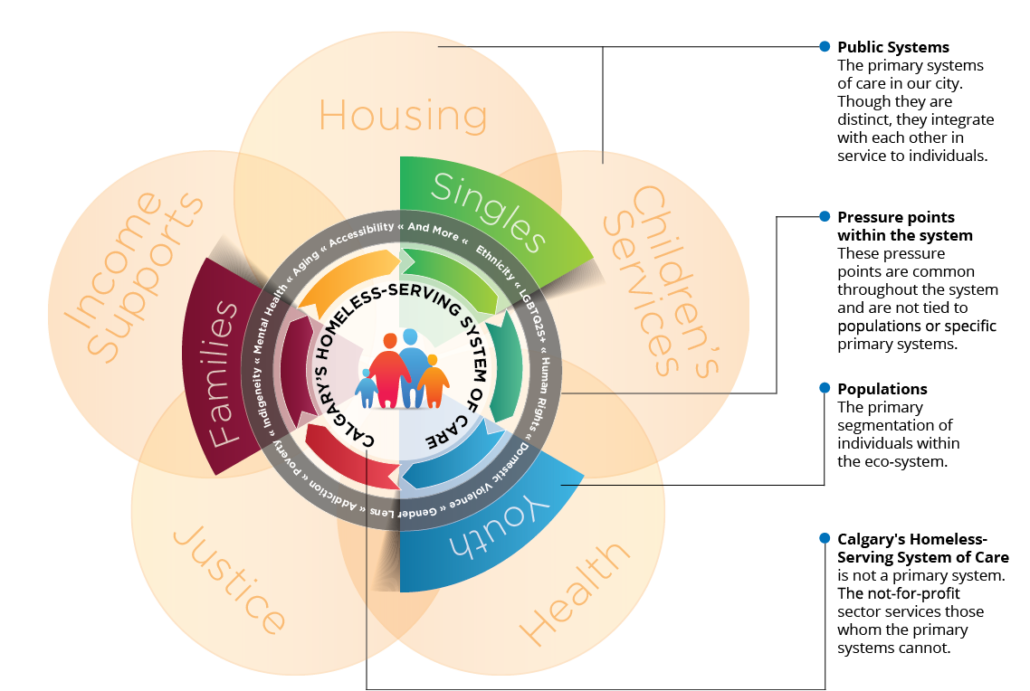Ecosystem Integration
Homelessness is a complex and multi-layered issue
Calgary Homeless Foundation and all the homeless-serving agencies within our city operate within a broader ecosystem that is designed to support those in need. This ecosystem is made up of what we call the Primary Public Systems, and our own secondary, or “default,” system called Calgary’s Homeless-Serving System of Care, or CHSSC.
How these Primary Public Systems work together can either contribute to homelessness—or help end it. While it is not the sole factor, our experience over the past decade has shown us that the way these Primary Public Systems relate to one another can impact how effective they are in assisting those they are designed to serve.
When it comes to solving homelessness, we must keep in mind that while these public systems are interrelated, they primarily function as distinct silos, which is how they may unknowingly contribute to homelessness in our city.

Public System: Housing
A focus on creating enough housing is obviously a key strategy when it comes to solving homelessness. Currently, Calgary is working towards increasing the supply of non-market housing to provide homes to a minimum of 6% of households. This will bring Calgary in line with the national average across Canada, and meeting this standard means that we need to develop at least 15,000 new non-market homes in addition to maintaining the current supply.[1] In our work guiding the fight to end homelessness, we continually call on public, non-profit, and private sector partners to make up this critical shortage. In 2015, key housing stakeholders in Calgary formed the Community Housing Affordability Collective (CHAC) to improve housing affordability in our city through cross-sector collaboration.
Public System: Health
Policy decisions dating back to the mid-1990s, including the downsizing of many hospitals and mental health facilities in Alberta, have resulted in diminished support for individuals with what we call co-morbidity, or people who have mental illness, physical health issues, and/or engage in substance misuse. These conditions, while not the cause of homelessness, can contribute to and worsen the experience of homelessness.[2] Individuals who are experiencing homelessness continue to struggle with receiving the right health services in the public system, and often, our secondary system is left to manage their needs.
Public System: Justice
The Justice System serves a large percentage of individuals with social service or treatment needs and is not equipped to provide adequate services for those issues, which leaves a gap for them to cycle through the system. When individuals’ basic needs (housing, health care, etc.) are not met, a cycle of persistent low-level offending can be created. For those who gain access to care because of their involvement with the Justice System, that care is often delayed, because there are insufficient processes within the current structure to quickly connect them to services (i.e. psychiatrist, detox, recovery treatment, etc.) When these treatment options are not provided by the system, these individuals tend to stay in the Justice System much longer than they should.
Public System: Income Support
There are also potential shortcomings in our Income Supports system as well. A substantial portion of Calgary Homeless Foundation’s annual program budget goes towards providing rent supplements to individuals and families in Calgary. This is not surprising, as we know that a large portion of Calgary’s population is overspending on housing in our city.

The Secondary, or “Default” System
Calgary’s Homeless-Serving System of Care (CHSSC) is what we refer to as a secondary system, or a “default system.” This array of non-profit agencies, community partners, and faith communities are all coordinated and focused on efforts to solve homelessness in our city. This default system is only a part of the greater ecosystem, and it relies on nonprofits to deliver key programs to vulnerable individuals who fall through the cracks within the primary systems.
Ecosystem Integration
Calgary Homeless Foundation acts as a bridge between these systems, bringing them together so they can work more effectively. In guiding the fight against homelessness, integrating all the services offered throughout the ecosystem requires coordination, system planning, and collaborative approaches to solving complex problems.
[1] The City of Calgary (2018). Corporate Affordable Housing Strategy Q2 2018 Update (escribemeetings.com)
CONTACT US
Calgary Homeless Foundation
Calgary House
Suite 1100, 550 6 Ave. SW
Calgary, Alberta, Canada T2P 0S2
Ph: (403) 237-6456
Fax: (403) 262-2924

